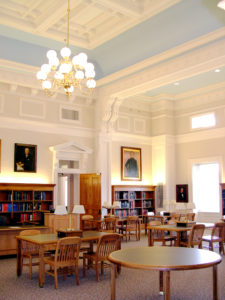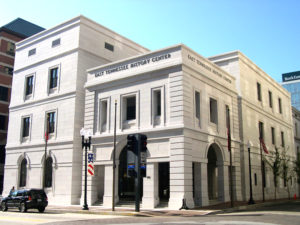By Steve Cotham, McClung Collection Manager
This article appeared in the Volume 1, Issue 2 Fall 2019 issue of the Appalachian Curator. Click here to view a PDF of the full issue.
The Calvin M. McClung Historical Collection was created in 1919 with the donation of Calvin McClung’s personal library to Lawson McGhee Library, Knoxville’s public library. McClung carefully built his outstanding private collection of local and regional history over the course of his lifetime, and the new library department became a significant resource for the community and researchers interested in East Tennessee subjects. The McClung Collection will celebrate its centennial on June 15, 2021. Today the collection has 75,000 books; 25,000 reels of microfilm; 5,100 linear feet of manuscripts; 200,000 photographs and negatives; 10,000 newspapers and 500 bound volumes of newspapers; and 3,836 maps.

Lawson McGhee Library (1886) is the cornerstone of the present Knox County Public Library, which is the oldest continuously existing public library in Tennessee. During the era when the McClung Collection was founded, there was a growing community of people in Knoxville interested in the arts and literature (Nicholson Art League), social issues such as woman suffrage (Ossoli Circle), as well as conservation of resources (National Conservation Exposition, 1913) and local history (the East Tennessee Historical Society). There were interlocking friendships and relationships between staff of the public library and members of these groups. The library was led by a dynamic new young librarian, Mary U. Rothrock. There were art exhibits by local artists and cultural programs on all sorts of topics in the new free public library.
Among supporters of the new library department were Smoky Mountains enthusiasts James E. Thompson, Bob and Margaret Howes, Harvey and Ann Broome, and Roger and Alice Howell. The Smoky Mountains Hiking Club was established in 1924, and the McClung Collection contains collections from many early members and supporters of the SMHC, including Charles Barber, Henry R. and Mary Deaderick Duncan, Paul M. Fink, Harvey Broome, James E. (Jim) Thompson, Carlos C. Campbell, Roger H. Howell, Russell Hanlon, Robert Cook, and Marshall Wilson. Not all of these collections relate to the Great Smoky Mountains, but a great many of them do, in all or in part. Harvey Broome, a founder of the Wilderness Society, and Paul M. Fink, a key member of the Nomenclature Committee for the Great Smoky Mountains National Park, have especially significant collections. Important photograph collections of the Great Smoky Mountains include James Thompson, Paul Fink, Harvey Broome, and Roger Howell.
The Calvin M. McClung Historical Collection has been the archival caretaker of the Smoky Mountains Hiking Club’s records since 1956. The announcement to the SMHC Board on April 24, 1956 reads as follows: “Helen Lewis proudly reported that the SMHC historical records are now in the McClung room at the Lawson-Magee (sic) Library
Helen and Margaret Howes spent an entire day getting the material in shape for deposit there.” Margaret Howes was Harvey Broome’s sister and a librarian at Lawson McGhee Library. These records were placed in the library with the hope that they would not be scattered over the years with changing officers in the club. After the initial receipt of records, the library has faithfully added new records and publications to the originalset of records as received from the club.
One of the most unique collections in the library is the Westwood Collection, family papers from the Armstrong family of Knoxville and East Tennessee spanning over three generations. Drury Paine Armstrong (1799-1856)

was an important civic leader and businessman in Knoxville. In addition, he owned 50,000 acres of land in the Great Smoky Mountains and operated a large farm, Glen Alpine, in the mountains in Sevier County. Robert Houston Armstrong (1825-1896) was a civic leader and served as the longtime treasurer of the East Tennessee Mental Hospital near Knoxville. Adelia Armstrong Lutz (1859-1931) was a noted artist who lived in Knoxville her entire life. She was married to John E. Lutz (1854-1920) and was the mistress of Westwood, which included a major artist’s studio in the house for painting. The three Armstrong houses—Crescent Bend, Bleak House, and Westwood—are still standing today along Kingston Pike, on what was originally the home farm of the Armstrong family.
The library has over 500 reels of microfilm from the National Archives relating to Cherokee Indians in Tennessee. These records, the majority created between 1800-1929, include the letters and records of the Cherokee Indian Agency in Tennessee, the Cherokee Indian Agency in Tennessee, the Superintendent of Indian Trade, the Office of Indian Affairs and others.
The Tennessee Archive of Moving Image and Sound (TAMIS), the newest initiative of the Knox County Public Library, is dedicated to collecting, preserving and providing access to the moving image and recorded sound heritage of East Tennessee. Film and video holdings include amateur home movies shot by local residents, industrial and educational films, local newsreels, and commercial Hollywood films produced in the region. Audio recordings dating back to the 1920s include vintage radio programming, home and studio music recordings, and oral histories and field recordings from the region.
Collections include the Thompson Family and Jack Huff Film Collections, which contain some of the earliest images of the Great Smoky Mountains and its inhabitants; the Marie Cirillo Videotape Collection, documenting former coal mining communities in upper East Tennessee during the 1970s; recordings of the Mid-Day Merry-Go-Round and other regional radio broadcasts that reached listeners for hundreds of miles; local television holdings including news reels, commercials produced by local advertising firms, and musical variety shows such as the Cas Walker Farm and Home Hour. The items in these and hundreds of other collections are unique to TAMIS and offer an intimate, compelling view of southern Appalachian people and their culture throughout the 20th century.
2 Comments
Cenda Price
Scanning for harp song books, I stumbled onto vinyl recordings by John Lomax of Smokey Mountain Ballads on abebooks. Please advise as to whether or not your McClung collection has sound recordings and in particular, if this one is present. Thanks in advance, Cenda
Gene Hyde
Hi Cenda – Please contact the McClung Collection directly for your query. Their phone number is on this page: https://www.knoxlib.org/local-family-history/calvin-m-mcclung-historical-collection
Thanks